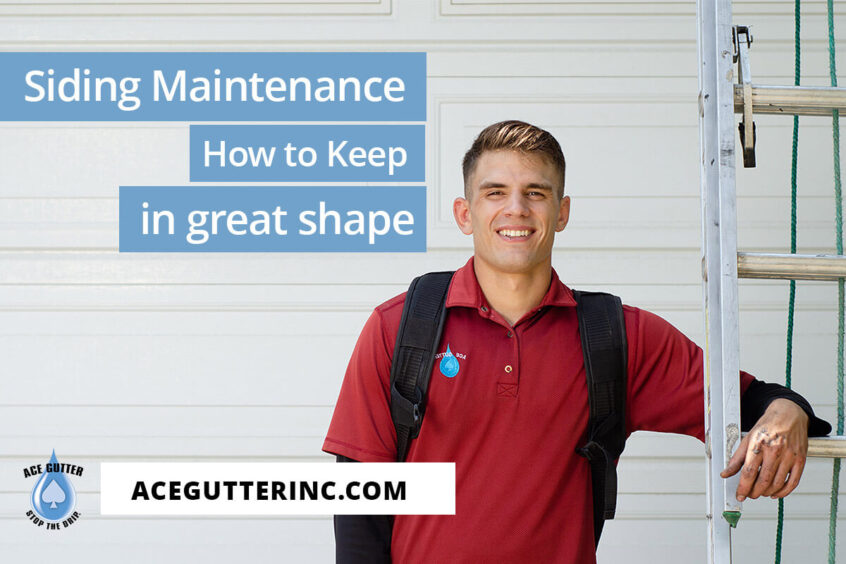Most people think of a siding as nothing more than a fashion statement. While that’s true, a siding does more than just adding curb appeal to your house. It also protects your house. That’s why it is necessary to pay attention when buying siding for homes. When chosen and installed correctly, you can avoid costly siding repairs down the line.
Let’s explore different types of siding, how it protects your home, and what you can do to keep it in good shape.
Types of Sidings
When it comes to siding for homes, there are plenty of choices. But the four most popular types of sidings are:
1. Wood
Wood siding is probably the most popular choice because it comes in virtually limitless styles, colors, and finishes. It comes with an unmatched aesthetic appeal. Also, wood siding repairs are relatively easy. But, it is prone to rot, insects, and damage due to sunlight. That’s why it often requires a coat of paint/stain, which calls for regular maintenance.
2. Vinyl
Vinyl siding requires low maintenance and is more affordable and durable. Like wood siding, it also boasts a variety of colors, styles, and finishes. But, it may not be as appealing as its wooden counterpart. Besides, you need immediate siding repairs if there is damage.
3. Metal
Popularly called retrofit siding, metal siding is a durable and low-maintenance alternative. Now, you can get metal siding with vinyl or plastic coating. The coating makes it last longer, and it doesn’t bleed on your walls.
4. Fiber Cement
Fiber cement siding is also durable and low maintenance. Usually made from recyclable materials, this siding closely resembles wood siding. It comes in different styles, such as beveled planks, shingles, shakes, and stucco-panel.
How Does A Siding Protect Your Home
Each type of siding offers unique benefits. But, whichever siding you choose, it will protect your home in the following three ways.
1. Keeps Your Home Cool
The siding insulates your home. It works with your existing insulation and interior walls to protect your house from getting too hot during the summers. With proper siding installation, you can spend your summers in comfort.
During the winters, it keeps in the heat produced by your furnace. Thus, keeping you warm and comfortable through the cold season. If your siding is damaged, a constant cold breeze will enter your house, forcing your furnace to work harder. In other words, siding can help you save considerably on your energy bills.
2. Prevents The Risk Of Water Damage
The siding also protects your home from snow and rain. Rainwater is the worst enemy of your house. It can damage your house to its very foundation, especially if the damage goes unnoticed.
Without proper siding installation or care, rainwater can enter the frame of your home. Once trapped between the joints or within the walls, it will quickly result in rot, mold growth, and other structural damage. Over time, you may also have to face foundation issues.
Essentially speaking, the siding adds a layer of waterproofing to your house. You must take the necessary steps to keep it in top shape.
3. Provides Additional Support To The Structure
The siding acts as a barrier between the core structure of your house and the outside weather. The damage caused by gushing winds could be much worse if there was no siding. In a way, sliding provides additional support to the structure of your house. That’s why siding installation, repair, and maintenance need to be spot on.
Tips For Avoiding Untimely Siding Repairs And Damages
As the siding has to withstand harsh weather, it is bound to get damaged at some point. But with regular upkeep, you can increase its lifespan and avoid costly siding repairs.
1. Inspect It Regularly
Regular inspection can help you prevent many problems in the coming years. Given that your siding faces wind, snow, and rainwater throughout the year, you should inspect it at least once every three months.
Simply taking a walk around the house can help you identify damage like peeling paint, rot, cuts, and holes. You should also check interior walls because moisture sipping through the siding peels off the paint and/or wallpaper.
It is a good idea to get it checked by professionals. Professionals can help you identify potential issues that an average eye is likely to miss. Call your go-to siding repair service provider for inspection once or twice a year.
2. Look For Potential Damage
When inspecting your siding, watch out for the following signs of damage.
- Look for peeling paint or sagging wallpaper inside your home. The most likely cause of such damage is the moisture buildup inside your siding.
- On the outside, watch out for cracks and holes in your siding. Cracked siding is an eyesore. But it also exposes the underlying wood to water damage and insect or rodent (mice) infestation.
- Another sign you have to watch out for is mold and mildew. Mold and mildew can damage both the exterior and interior of your siding.
- Crumbling or rotting siding is also a sign of extensive water damage.
Siding repairs involving mold and mildew are often challenging and expensive, especially if the damage is widespread. So, it’s necessary to detect these issues as early as possible.
If you see even the smallest moisture buildup or any other kind of external wear and tear, call a siding installation and repair expert immediately.
3. Clean It At Least Twice A Year
Visual inspection alone is not enough. As it is prone to mold, mildew, and other infestations, your siding also requires a deep clean, once or twice a year. Besides, a deep clean is much cheaper than last-minute siding repairs.
But, you do need to take a few precautions when cleaning your siding. For instance, you should never use abrasive scrubbers or cleaning products. They can damage your siding.
You can use a cleaning mix depending on the type of your siding. For example, a cleaning mix of 30% vinegar and 70% water is suitable for vinyl siding.
For wood siding, you can use equal parts bleach and water. But, make sure to try it on a small area first. Use it only if it doesn’t cause damage.
You may need to use store-bought siding cleaners to clean up tough mold and mildew spots. The best way to clean your siding, however, is a power wash.
But, you have to keep a few things in mind.
- Clear the outside area of your house before the cleanup.
- Wrap light fixtures with a plastic tarp for protection.
- Tape down the edges of your windows, skylights, and doors.
- Close all doors, windows, and vents.
- Keep the stream at eye level.
- Point the nozzle directly at the siding.
- Clean the siding in sections.
- Use safety gear and take precautions when cleaning.
If you are not a DIYer, you can hire a professional. Most gutter cleaning service providers can also help you with siding cleanup.
4. Use The Right Products
After siding repairs and cleanup, you may need a fresh coat of paint or stain to restore the curb appeal of your home. When doing so, make sure to choose the right product.
Usually, it depends on the type of your siding. If you have wood siding, use the same stain as the original. For instance, if the original stain was solvent-based, make sure to use a solvent-based stain for restoration.
When painting vinyl siding, always use vinyl-safe colors. Avoid using dark shades as they absorb heat. Dark paint will bubble and flake off over time. And if you are not sure what restoration product to use, talk to a professional.
In Conclusion
Siding plays a critical role in keeping your house safe from the rain, snow, and wind, among other things. You have to make sure it receives proper care on time. Fortunately, with regular inspection, cleaning, and restoration, you can avoid expensive repairs down the line. Of course, instead of doing all the hard work yourself, you can always call professionals like Ace Gutter for help.
Feel free to reach out to us at (801) 676-1048 or fill out our online contact form for a free bid. Our experts will be happy to help with all your Utah siding repairs, installations, and cleaning needs.


